Poisson Equation
Poisson's Equation
Definition

Description
Appears in almost every field of physics.
Solution to Case with 4 Homogeneous Boundary Conditions
Let's consider the following example, where  and the Dirichlet boundary conditions are as follows:
and the Dirichlet boundary conditions are as follows:
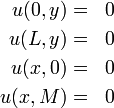
In order to solve this equation, let's consider that the solution to the homogeneous equation will allow us to obtain a system of basis functions that satisfy the given boundary conditions. We start with the Laplace equation: 
Step 1: Separate Variables
Consider the solution to the Poisson equation as  Separating variables as in the solution to the Laplace equation yields:
Separating variables as in the solution to the Laplace equation yields:


Step 2: Translate Boundary Conditions
As in the solution to the Laplace equation, translation of the boundary conditions yields:

Step 3: Solve Both SLPs
Because all of the boundary conditions are homogeneous, we can solve both SLPs separately.


Step 4: Solve Non-homogeneous Equation
Consider the solution to the non-homogeneous equation as follows:

We substitute this into the Poisson equation and solve:
![\begin{align}
F(x,y)& = u_{xx}+u_{yy} \\
& = \sum_{m,n=0}^\infty \left \{ a_{mn}\left \lbrack -\frac{(m+1)^2\pi^2}{L^2} \right \rbrack \sin \frac{(m+1)\pi x}{L} \sin \frac{(n+1)\pi y}{M} \right \} +
\left \{ a_{mn}\left \lbrack -\frac{(n+1)^2\pi^2}{M^2} \right \rbrack \sin \frac{(m+1)\pi x}{L} \sin \frac{(n+1)\pi y}{M} \right \} \\
& = \sum_{m,n=0}^\infty \underbrace{\left [ -a_{mn} \left ( \frac{(m+1)^2\pi^2}{L^2}+\frac{(n+1)^2\pi^2}{M^2} \right ) \right ]}_{A_{mn}} \sin \frac{(m+1)\pi x}{L} \sin \frac{(n+1)\pi y}{M}
\end{align}](../I/m/07408f441e6fc6895088fc6abecdce83.png)
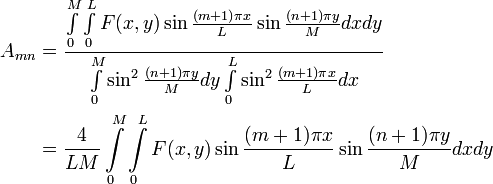
![a_{mn}=-\frac{4}{LM\left [ \frac{(m+1)^2\pi^2}{L^2} + \frac{(n+1)^2\pi^2}{M^2} \right ]}\int\limits_0^M \int \limits_0^L F(x,y) \sin \frac{(m+1)\pi x}{L} \sin \frac{(n+1)\pi y}{M} dx dy; m,n=0,1,2,\cdots](../I/m/a86e5fa0962705d94653ccbb92985b33.png)
Solution to General Case with 4 Non-homogeneous Boundary Conditions
Let's consider the following example, where  and the boundary conditions are as follows:
and the boundary conditions are as follows:
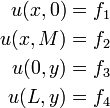
The boundary conditions can be Dirichlet, Neumann or Robin type.
Step 1: Decompose Problem
For the Poisson equation, we must decompose the problem into 2 sub-problems and use superposition to combine the separate solutions into one complete solution.
- The first sub-problem is the homogeneous Laplace equation with the non-homogeneous boundary conditions. The individual conditions must retain their type (Dirichlet, Neumann or Robin type) in the sub-problem:
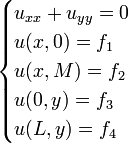
- The second sub-problem is the non-homogeneous Poisson equation with all homogeneous boundary conditions. The individual conditions must retain their type (Dirichlet, Neumann or Robin type) in the sub-problem:
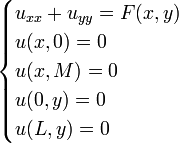
Step 2: Solve Subproblems
Depending on how many boundary conditions are non-homogeneous, the Laplace equation problem will have to be subdivided into as many sub-problems. The Poisson sub-problem can be solved just as described above.
Step 3: Combine Solutions
The complete solution to the Poisson equation is the sum of the solution from the Laplace sub-problem  and the homogeneous Poisson sub-problem
and the homogeneous Poisson sub-problem  :
:
